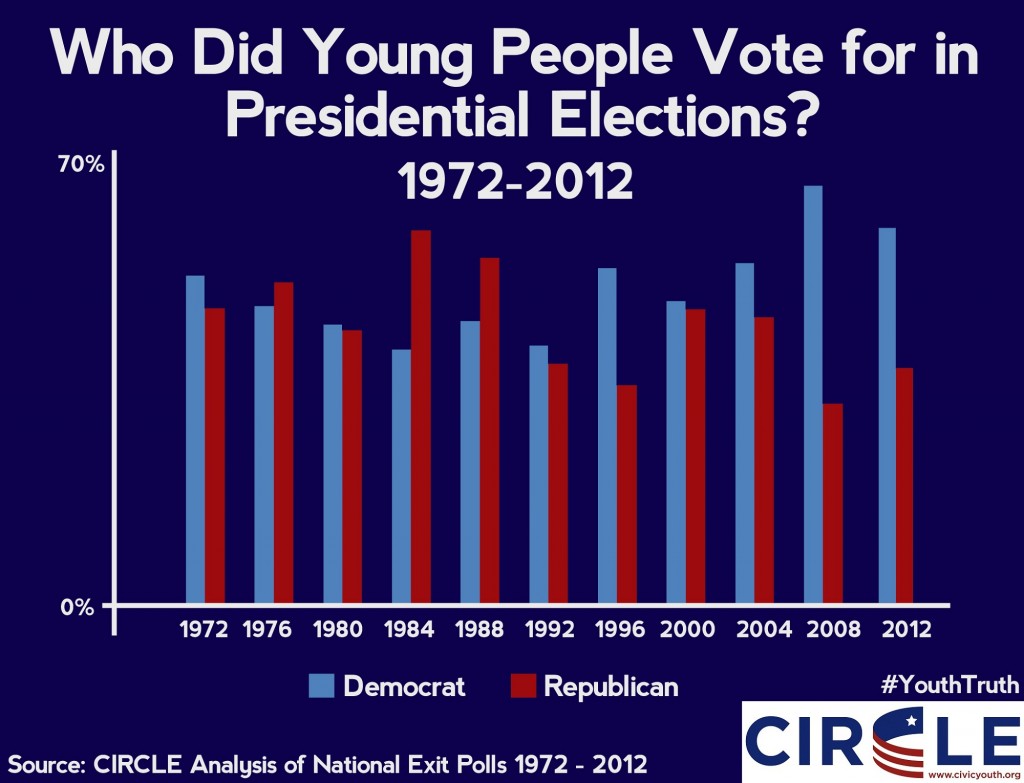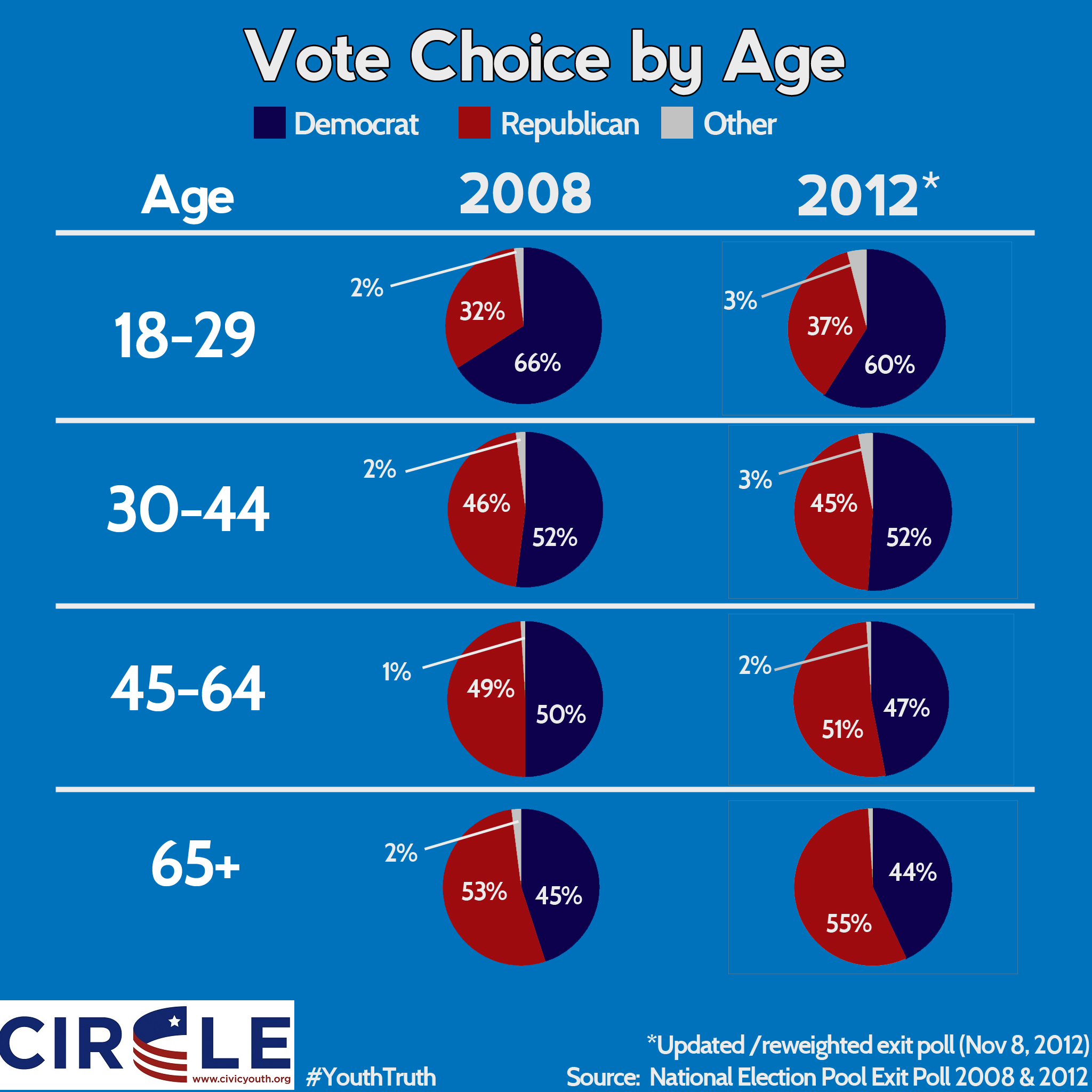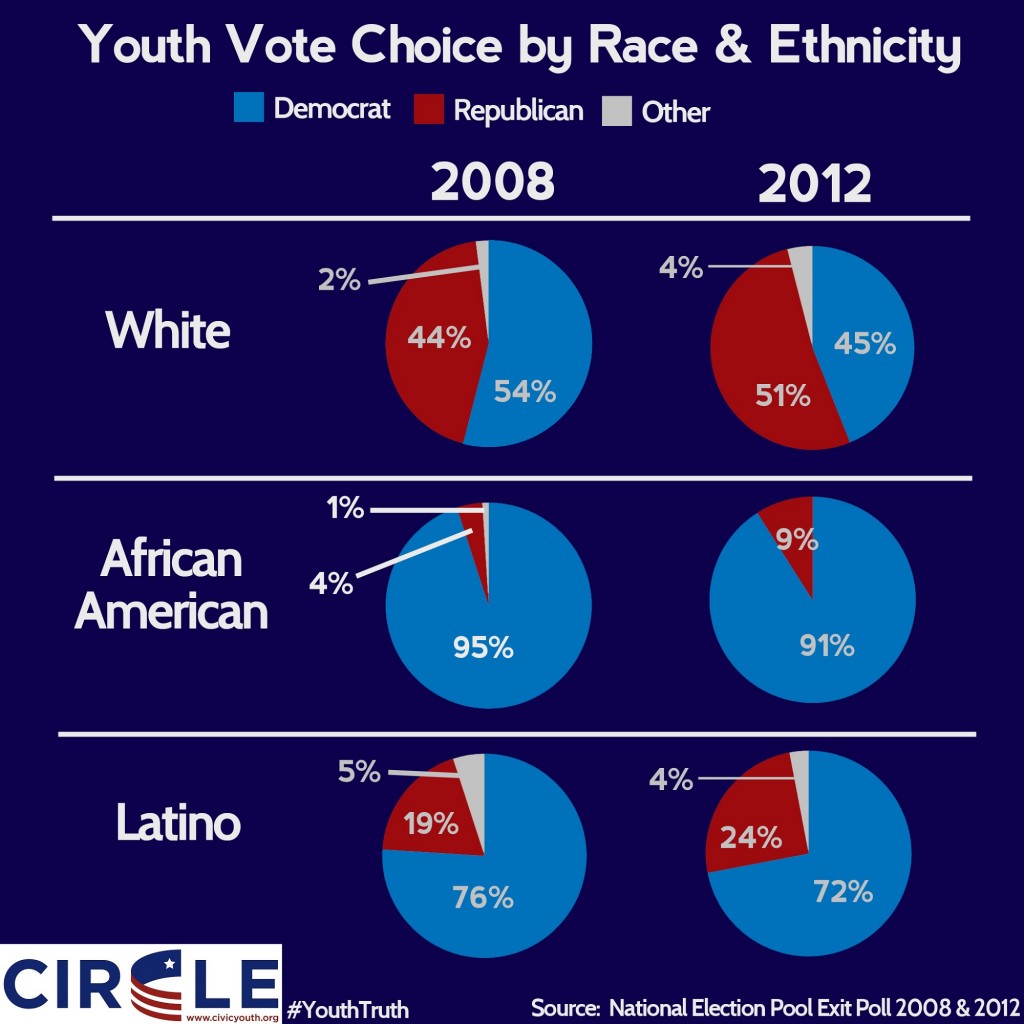EARLY EXIT POLLS: Youth Represent 19% of Voters, Up 1 Point from 2008
CIRCLE to Release Exclusive Turnout Estimate Tomorrow
Joint Press Call w/ Rock the Vote at 12noon (ET) to Discuss Turnout & Provide Analysis
Medford/Somerville, Mass. – Young people (ages 18-29) represented 19% of the voters in today’s election, with President Obama winning the majority of those votes over Governor Romney by 60% to 36% 37% (exit poll was updated/re-weighted), according to the early released National Exit Poll (NEP) conducted by Edison Research. This is one point higher than in 2008, when young voters represented 18 percent of voters in the presidential election, according to the NEP. (Note that Early National Exit Poll data are subject to reweighting.)
Tomorrow, the Center for Information and Research on Civic Learning and Engagement (CIRCLE) – the preeminent youth researchers at Tufts University – will be releasing an exclusive youth turnout estimate for the 2012 election. Turnout is the only statistic reflecting either an increase or decrease in youth voting this election. CIRCLE’s exclusive youth turnout number and further analysis will be discussed during a national press conference call being held by CIRCLE and Rock the Vote. To reserve a line on the call please RSVP to brad@lunamediagroup.com.
“The role young people would play during this election has been a major question in American politics for over a year, and it seems the answer is that they have been as big a force at the polls in 2012 as in 2008,” said CIRCLE Director Peter Levine. “They again supported President Obama, although not as lopsidedly as in 2008. Until tomorrow, it will be unclear whether youth turnout–or the turnout of any group–rose or fell, but young people were proportionately well represented in the 2012 electorate.”
The 19% share does not indicate how many young people voted or whether there was a rise in youth turnout. In 2004, the youth share of the vote remained constant even though youth turnout rose. (See the table below for more information on the difference between turnout and share.) Young people represent about 21% of the voting-eligible population, according to CIRCLE’s analysis of Census data.
The chart below highlights the difference between turnout and share. The youth share (percentage of voters who are young) has stayed steady since 1996 as more people of every age have voted. Youth turnout, on the other hand, has grown consistently, with half of all 18-29 year olds voting in the 2008 election.
There is no official count of voters by age. Therefore, any statistic on youth share or youth voter turnout is an estimate based on survey data. Like any survey, the National Exit Polls use methods that may introduce sampling bias. However, our estimates of youth turnout from the National Exit Polls (shown above) have produced a trend that closely tracks the trend in the Census Current Population Survey (CPS), which is the other reliable source for estimating youth turnout. Since CPS voting data for 2012 will not be available until spring 2013, our method produces the only current and reliable estimate of youth turnout.
Young voters preferred Obama
Young voters preferred Obama over Romney by 60% to 36% 37% (exit poll was updated/re-weighted) in the NEP. That represented a somewhat narrower margin than in the 2008 election, in which Obama took 66% of young voters. Before 2008, in elections from 1976 through 2004, young voters diverged by an average of only about 2 percentage points from the popular vote as a whole.











November 7th, 2012 at 8:23 am
[…] best reports I could find at 2:48 AM (EST) put the youth vote at 60% Obama, 36% Romney. (See CIRCLE and Tyler Kingkade at […]
November 8th, 2012 at 1:23 pm
[…] to CIRCLE, “EARLY EXIT POLLS: Youth Represent 19% of Voters, Up 1 Point from 2008“, in a survey published by CIRCLE. See full text here. VN:F [1.9.20_1166]please […]
November 10th, 2012 at 3:16 pm
[…] been hit hardest by the post-2008 economy) and only to a lesser extent by young minorities. The CIRCLE crosstabs on the exit poll, shown below, confirm that this is indeed what happened. Note that this time, unlike in ’08, the […]
November 11th, 2012 at 1:44 pm
[…] a state like Ohio, young voters may have made a difference (by about 12,000 votes), but not enough for Facebook to be the pivotal factor. Facebook only […]
November 11th, 2012 at 4:39 pm
[…] a state like Ohio, young voters may have made a difference (by about 12,000 votes), but not enough for Facebook to be the pivotal factor. Facebook only […]
November 11th, 2012 at 7:40 pm
[…] voters dropped around 6 percent (probably from 66 percent to 60 percent).In a state like Ohio, young voters may have made a difference (by about 12,000 votes), but not enough for Facebook to be the pivotal factor. Facebook only […]
November 12th, 2012 at 10:02 am
[…] That’s half of the entire 18- to 30-year-old demographic. Moreover, young voters made up a higher share (19 percent) of the overall electorate than did voters over 65 years of age (16 percent). So what […]
November 13th, 2012 at 11:30 am
[…] percent of the electorate in 2012, up from 26 percent in 2008. Voters aged 18-29 also boosted their share of turnout, from 18 percent to 19 […]
December 5th, 2012 at 12:29 am
[…] turns out that 18- to 29-year-olds did vote—and in record numbers. At 19 percent of the electorate, youths represented a greater portion of the voting sector than […]
December 16th, 2012 at 9:19 pm
[…] like much but for three straight elections — 1996-2004 — their share of the electorate stayed the same at 17%. So why did youths continue to support Mr. Obama? Mostly social issues. His (newfound) but […]
December 16th, 2012 at 9:41 pm
[…] like much but for three straight elections — 1996-2004 — their share of the electorate stayed the same at 17%. So why did youths continue to support Mr. Obama? Mostly social issues. His (newfound) but […]
December 17th, 2012 at 3:49 am
[…] sound like much but for three straight elections — 1996-2004 — their share of the electorate stayed the same at 17%. So why did youths continue to support Mr. Obama? Mostly social issues. His (newfound) but […]
December 20th, 2012 at 10:05 pm
[…] sound like much but for three straight elections — 1996-2004 — their share of the electorate stayed the same at 17%. So why did youths continue to support Mr. Obama? Mostly social issues. His (newfound) but […]
January 7th, 2013 at 8:58 am
[…] voters represented 19% of all voters in 2012, compared to 18% in 2008, and a whopping 60% of those voted for Obama, making it clear that young […]